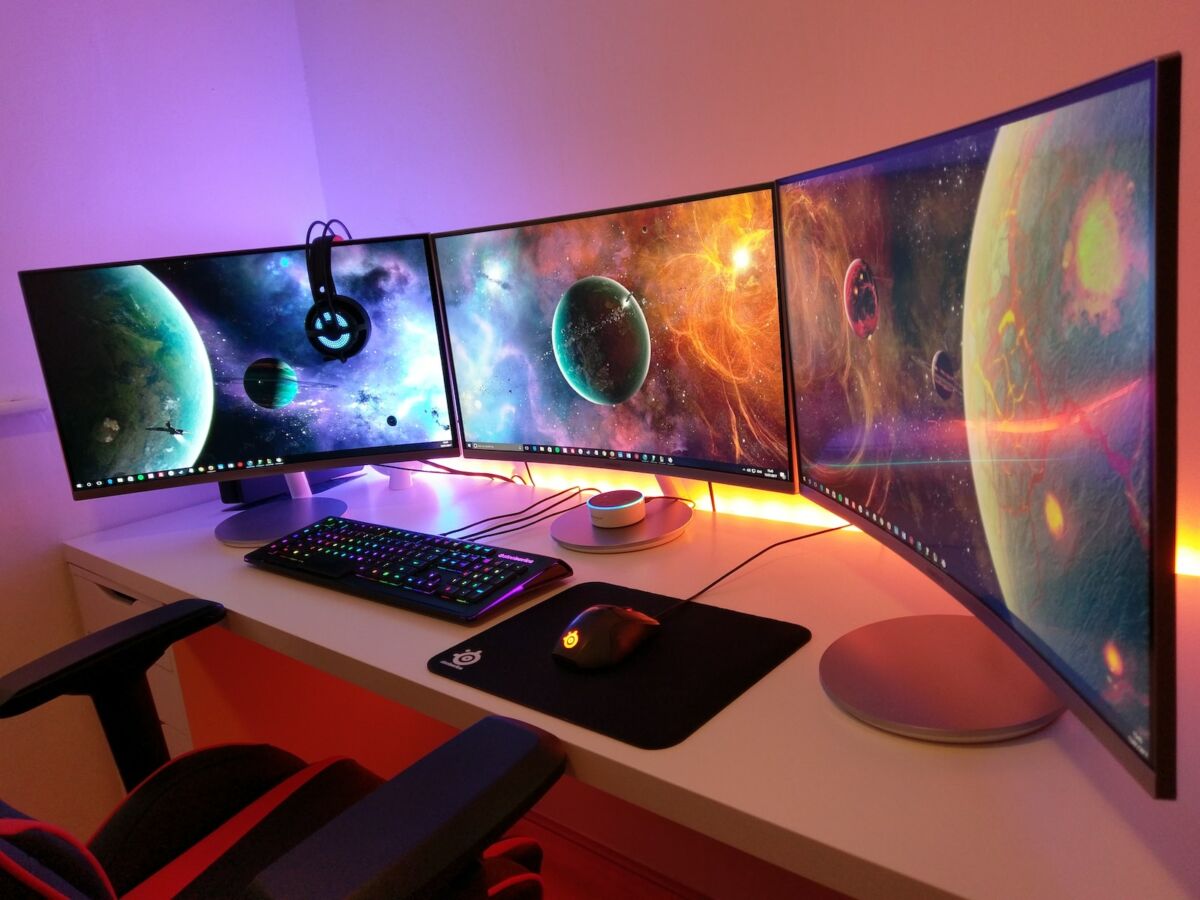Are you in the market for a new monitor and wondering if a 4K display is worth the investment? While 4K monitors offer a higher resolution and more pixels than their 1080p counterparts, it’s important to consider whether you truly need one for your intended use.

For gamers, a 4K monitor can provide stunning graphics and a more immersive experience. However, it’s important to have a powerful GPU to handle the increased demand for processing power. Additionally, not all games are optimized for 4K resolution, so it’s important to research compatibility before making a purchase.
When it comes to content creation, a 4K monitor can offer more screen real estate and improved visual quality for tasks such as photo and video editing. However, it’s important to consider other factors, such as color reproduction and contrast ratios, which can vary between different types of panels like TN and IPS.
What Is a 4K Monitor?
If you’re in the market for a new monitor, you may have heard the term “4K” thrown around. But what exactly is a 4K monitor? In short, a 4K monitor is a display with a resolution of 3840 x 2160 pixels, which is four times the resolution of a standard 1080p monitor.
Resolution Explanation
Resolution refers to the number of pixels that make up an image on a screen, with more pixels resulting in a higher level of detail. A 4K monitor has a resolution of 3840 x 2160 pixels, which means there are over 8 million pixels on the screen. This high level of detail makes 4K monitors ideal for tasks that require precise detail, such as photo and video editing and gaming.
Pixel Density
Pixel density refers to the number of pixels per inch (PPI) on a screen. A higher pixel density means individual pixels are smaller and closer together, resulting in a sharper and more detailed image. 4K monitors typically have a higher pixel density than standard 1080p monitors, which means that text and images appear sharper and more detailed on a 4K monitor.
However, it’s important to note that not all content is optimized for 4K resolution. While more and more content is becoming available in 4K, many websites and applications are still designed for standard 1080p resolution. This means that some content may appear smaller on a 4K monitor and may require scaling or zooming to be easily readable.
Overall, whether or not you need a 4K monitor depends on your specific needs and use case. If you work with high-resolution content or require precise detail, a 4K monitor may be worth the investment. However, if you primarily use your computer for browsing the web or watching videos, a standard 1080p monitor may be sufficient.
Benefits of a 4K Monitor

Visual Quality
If you want to enjoy the best visual quality, a 4K monitor is the way to go. With a resolution of 3840×2160 pixels, 4K monitors offer four times as many pixels as a standard 1080p monitor. This means that you get sharper, clearer, and more detailed images, making it ideal for photographers, graphic designers, or anyone who needs to work with high-quality visuals.
4K monitors also support a wider color gamut, meaning you can see more colors than a standard monitor. This is especially important for professionals who work with color-critical applications, such as video editing or graphic design. You can also enjoy HDR content on a 4K monitor, which provides a more immersive viewing experience with better contrast, brightness, and color accuracy.
Screen Real Estate
Another benefit of a 4K monitor is the increased screen real estate. With more pixels on the screen, you can fit more content on it, which is especially useful for multitasking. You can have multiple windows open side by side or work on a large project without having to zoom in and out constantly.
4K monitors also offer a higher pixel density, meaning you can sit closer to the screen without seeing individual pixels. This is great for anyone who spends a lot of time in front of a monitor, as it reduces eye strain and fatigue.
Gaming Experience
If you’re a gamer, a 4K monitor can take your gaming experience to the next level. With more pixels on the screen, you get a more immersive experience, with sharper and more detailed images. You can also see more of the game world at once, which can give you a competitive advantage.
However, remember that gaming at 4K requires a powerful graphics card, so make sure your computer can handle it before investing in a 4K monitor.
Factors to Consider
If you’re considering purchasing a 4K monitor, there are a few factors you should keep in mind before making your decision. Here are some things to consider:

Price
The price is one of the biggest factors to consider when purchasing a 4K monitor. 4K monitors can be quite expensive, with some models costing over $1,000. If you’re on a tight budget, you might want to consider a lower-resolution monitor instead.
Hardware Requirements
Another factor to consider is whether your computer can handle a 4K monitor. To display content at 4K resolution, you’ll need a graphics card that can support it. If your graphics card isn’t up to the task, you might need to upgrade it before purchasing a 4K monitor.
In addition to a graphics card, you’ll also need a monitor with a DisplayPort 1.2 or HDMI 2.0 port, as these are the only ports that can transmit 4K content at 60Hz. If your monitor doesn’t have one of these ports, you won’t be able to take full advantage of its 4K capabilities.
Content Availability
Finally, you’ll want to consider whether there is enough 4K content available to make purchasing a 4K monitor worth it. While more and more content is being produced in 4K, it’s still not as widely available as content in lower resolutions. If you primarily use your computer for tasks like web browsing and word processing, a 4K monitor might not be necessary.
However, if you’re a gamer or a video editor, a 4K monitor can significantly improve visual quality. Games and videos that are designed for 4K resolution will look stunning on a 4K monitor, with more detail and clarity than you would get on a lower resolution monitor.
Alternatives to a 4K Monitor
If you’re not sold on the idea of a 4K monitor, there are several alternatives that you can consider. Each of these alternatives has its benefits and drawbacks, so choosing the one that best fits your needs is important.

1080p Display
A 1080p display is the most common type of monitor available today. It offers a resolution of 1920×1080 pixels, which is lower than a 4K monitor but still provides a clear and sharp image. A 1080p display is a good choice if you’re on a budget or don’t need the extra resolution that a 4K monitor provides. It’s also a good option if you have an older computer or graphics card that can’t handle the demands of a 4K monitor.
However, a 1080p display may not be the best choice if you need to work with multiple windows or applications at the same time. The lower resolution means you’ll have less screen real estate to work with, which can be frustrating if you’re used to a larger display.
1440p Display
A 1440p display offers a resolution of 2560×1440 pixels, which is higher than a 1080p display but lower than a 4K monitor. It balances resolution and affordability, making it a popular choice for gamers and professionals alike.
A 1440p display is a good choice if you need a larger screen for multitasking or if you want to enjoy high-resolution gaming without breaking the bank. It’s also a good option if you have a mid-range graphics card that can’t handle the demands of a 4K monitor.
However, a 1440p display may not be the best choice if you need the highest level of detail and clarity. While it provides a sharper image than a 1080p display, it still falls short of the resolution provided by a 4K monitor.
Ultrawide Monitor
An ultrawide monitor offers a wider aspect ratio than a traditional monitor, which can be beneficial for certain tasks such as video editing or gaming. Ultrawide monitors typically have a resolution of 2560×1080 or 3440×1440 pixels, which provides a good balance between resolution and screen real estate.
An ultrawide monitor is a good choice if you need a larger screen for multitasking or if you want to enjoy a more immersive gaming experience. It’s also a good option if you need to work with multiple windows or applications at the same time.
However, an ultrawide monitor may not be the best choice if you need the highest level of detail and clarity. While it provides a wider aspect ratio than a traditional monitor, it still falls short of the resolution provided by a 4K monitor.
Conclusion

When it comes to deciding whether or not you need a 4K monitor, the answer is not a simple one. It depends on what you plan to use your monitor for and how much you will spend.
If you are a professional photographer or video editor, a 4K monitor can be a valuable tool for ensuring that your work is displayed in the highest possible quality. However, if you are a casual user who primarily uses your computer for web browsing and basic tasks, a 4K monitor may not be necessary.
It’s important to remember that a 4K monitor requires a significant investment, not just in the cost of the monitor itself but also in the hardware required to run it. You’ll need a powerful computer with a high-end graphics card to take full advantage of the monitor’s capabilities.
Ultimately, deciding to invest in a 4K monitor comes down to your specific needs and budget. If you have the money to spend and require the highest level of display quality, a 4K monitor may be worth the investment. However, if you are on a tight budget or don’t require the highest level of display quality, a standard monitor may be a better option for you.